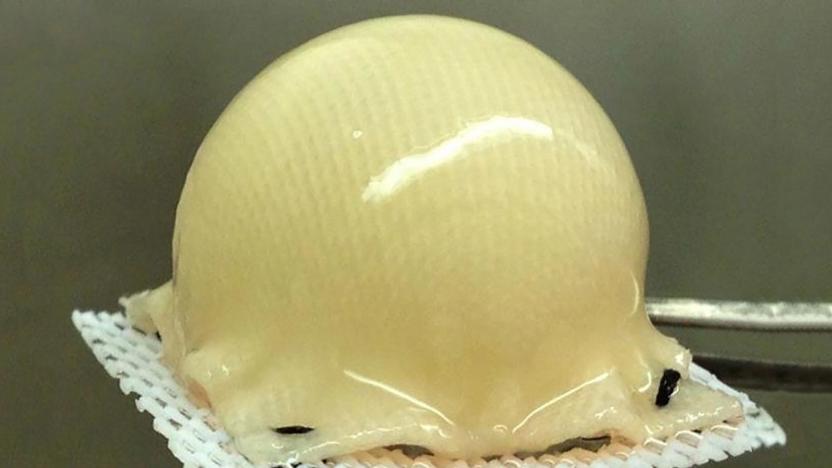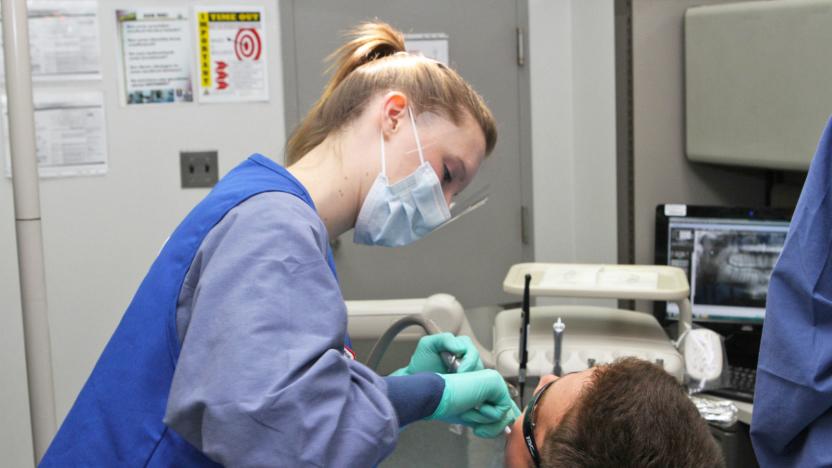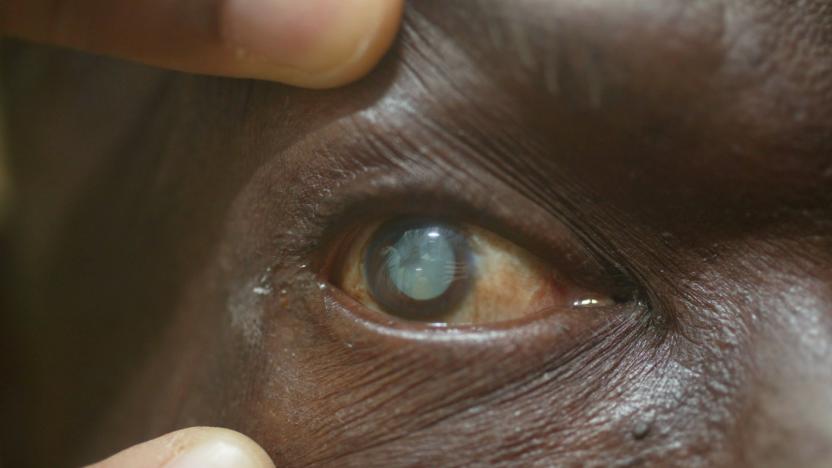stemcells
Latest

Scientists successfully bred baby mice from skin cells
A team of scientists at Japan's Kyushu University has successfully turned the skin cells of a mouse into mature egg cells used to breed viable offspring. According to a new paper in the journal Nature, the process could eventually be used in human reproduction without the need for egg cells at all.

Skin-grown cells could help you recover from heart attacks
Scientists have taken numerous shots at repairing hearts following heart attacks, but an experimental approach might do a better job than most. Japanese researchers are developing a technique that repairs hearts using cells grown from the skin of a genetically similar donor. If you convert stem cells into heart cells and inject them into affected areas, they can replace damaged tissue and help the organ pump more like it did before the attack.

NIH might start funding human-animal chimera studies
The NIH could start funding experiments that inject human stem cells in animal embryos to create hybrids called "chimeras." It issued a blanket ban on chimera research last year, but it looks like the organization changed its mind after examining the science behind it and talking to lead experts in the field. Carrie D. Wolinetz, NIH's Associate Director for Science Policy, wrote in a blog post that the "formation of these types of human-animal organism, referred to as "chimeras," holds tremendous potential for disease modeling, drug testing and perhaps eventual organ transplant."

Stem cell-based cartilage could fix your broken hip
Doctors want to 3D print transplantable organs from your own stem cells, but now they might be able to replace a bum hip, too. A team of scientists in St. Louis and Durham used stem cells to grow cartilage on a 3D "scaffold" that can be molded into the exact shape of a patient's hip joint. It could then be implanted onto the surface of the bone, replacing the regular cartilage that acts as a "lubricant" for the ball and socket-style joint. Since it would be made from your own stem cells, there's no chance of rejection.

Regenerative tooth fillings could put an end to root canals
You really don't want a root canal, and not just because it's potentially painful. Emptying the tooth of the infected tissue at its heart potentially weakens it, since you can't grow that organic material back or put toxic fillings in its place. Researchers may have a solution, though. They've crafted fillings that get the tooth's own stem cells to regenerate and repair tissue. This doesn't mean that your pearly whites would return to normal, but the substance could heal the tooth enough to spare you a root canal or prevent fillings from going south.

Scientists hope to save near-extinct rhinos by transforming cells
The northern white rhinoceros is in far worse straits than most rhinos. There are just three members of the species left, and they can't breed normally -- if nothing happens, extinction is guaranteed. And that's leading researchers to try a dramatic technological solution to keep the northern white rhino around. They're planning to transform both frozen and living rhino cells into stem cells that could grow into eggs and sperm for the in vitro fertilization of a surrogate southern white rhino. This would not only resurrect the species, but create enough diversity that the new population should survive in the wild.

'Biopen' lets doctors 3D print cartilage during surgery
If you need knee replacement surgery in the future, doctors may be able to create a custom-made joint from your own stem cells. A team from St Vincent's Hospital, Melbourne, have developed the Biopen, a type of 3D printer that uses "ink" made from hydrogel and stem cells. While 3D printing stem cells isn't new, the exact shape of a patient's cartilage often can't be known until they're cut open. Using the device, surgeons can precisely customize the joint to the patient with surgical "scaffolds," then permanently harden the biogel using ultraviolet light.

New research hints at stem cell treatments for cataracts
A pair of unrelated studies into the efficacy of stem cell-based treatments for correcting cataracts had the scientific community abuzz on Tuesday. The studies are "amazing, almost like science fiction" Mark Daniell, head of corneal research at the Centre for Eye Research Australia in Melbourne, told Nature News. "The potential of this technique is mind-boggling."

New stem cell treatment could 'cure' type 1 diabetes
Researchers at MIT and Harvard figured out how to produce pancreatic beta cells -- the ones that produce insulin -- in large quantities back in 2014. The same intercollegiate team announced in the journal Nature on Monday that they've now managed to implant those cells into mice that have been genetically designed to suffer from Type 1 diabetes -- without the cells being rejected. Even more impressive, the diabetic mice produced their own insulin during the 174-day study period, eliminating the need for daily injections. Instead, patients would simply need "booster" injections of beta cells once every few years.

Researchers 3D print 'Lego bricks' of functional stem cells
A team of scientists from Beijing's Tsinghua University have reportedly devised a means of producing uniform embryonic stem cells with a 3D printer. These cells stack like organic Lego bricks and could form the structural basis for future lab-grown organs. "It was really exciting to see that we could grow embryoid body in such a controlled manner," lead author Wei Sun said in a statement. "The grown embryoid body is uniform and homogenous, and serves as a much better starting point for further tissue growth." The study published yesterday in the journal Biofabrication.

Scientists create fully-functional brain neurons from mouse skin cells
It's a good excuse to shoehorn Pinky and the Brain on to the site, but scientists have managed to graft neurons reprogrammed from skin cells into the brains of mice. It isn't the first time that's been done, but it is the first time the researchers have had any luck with the neurons surviving into long-term stability. Better still, six months after implantation, the neurons had become fully-functional inside the brain. Cell replacement therapy would be able to treat neurodegenerative diseases like Parkinson's, replacing non-working neurons with new cells reprogrammed from elsewhere. It's still a ways off, however, according to stem cell research head Prof. Schwamborn: "I am sure successful cell replacement therapies will exist in future. Our research results have taken us a step further in this direction."

Scientists get much closer to cloning human embryos from adult stem cells
It's relatively easy to clone embryos from the adult stem cells of simpler animals like sheep, but humans have proved challenging. Even an attempt last year only used baby cells. The process just took a gigantic step forward, though, as scientists have finally used an adult human's stem cells to clone a pre-embryonic blastocyst. The process was mostly similar to that for other species: researchers removed the DNA from the nucleus of an unfertilized egg and inserted a skin cell into that egg. From there, the team only needed growth chemicals to develop the stem cells into specific cell types, such as heart tissue.

Researchers create 'programmable' stem cells through stress
Making stem cells in the lab is typically a complicated process, and there isn't much variety in the results without resorting to foreign DNA. However, researchers at both Brigham and Women's Hospital and Japan's RIKEN may have found a way to easily create most any stem cell a doctor would need. Their new technique subjects adult cells to extreme stress, such as oxygen deprivation. The victims that survive the process retreat into a state much like that of an embryonic stem cell; after that, scientists just have to grow the cells in the right environment to get the stem cells they want. It will be a while before the team tests this process with humans, but it could lead to stem cells tailor-made for specific patients -- you'd only have to provide a blood sample to get replacement tissues.

Tiny human brain models grown in lab with tiny cortex, tiny hippocampus (video)
Mouse brains were the first to be grown, but when it comes to discovering the inner workings of the human brain, as Juergen Knoblich of the Institute of Molecular Biology (IMB) in Austria put it: "mouse models don't cut it." The institute has managed to grow some adorable-sounding tiny human brain models that include parts of the cortex, hippocampus and retinas through stem cells. The lab-grown tissue will allow researchers to peer into the early stages of human brain development in far higher detail than ever before. Growing the little gray matter samples involved adult cells reprogrammed to behave like embryonic stem cells and giving them a cocktail of vital brain development nutrients. In under a month, they had grown to between 3 and 4mm across, with several structures that are found in the fully-formed versions. Through imaging techniques, the scientists were even able to pick up neural activity -- we've added the video after the break. The models are already providing insights and new ideas on brain development. According to the New Scientist, if the researchers were able to adjust their techniques to include stem cells that develop into blood vessels, future models could offer more detailed knowledge on conditions like schizophrenia and autism.

Scientists grow human liver from stem cells, hope to relieve transplant woes (video)
Stem cell research has resulted in several important breakthroughs in medicine, such as rebuilding the larynx and regenerating spinal cord connectors. Now the liver, one of the most highly sought after organs on the donor transplant list, could get some serious stem cell assistance as well. A team of scientists led by Takanori Takebe of Yokohama City University has successfully created a miniature version of the human liver with the help of induced pluripotent stem cells (iPSC), which are derived from adult somatic cells. They developed the iPSC into generalized liver cells called hepatocytes, at which point the researchers mixed in endothelial cells and mesenchymal stem cells, left the petri dishes alone for a couple days, and voila -- an extremely tiny version of a human liver, said to be the first-ever functional human organ grown from stem cells, was born. The liver "buds," as they're known, measure five millimeters long and are the sort you would find in human embryos shortly after fertilization. When implanted in mice, the baby livers managed to perform all the functions of their adult equivalents. The researchers' next step would be to generate liver buds that are a touch closer to normal liver tissue -- like the addition of bile ducts -- and to see if they can mass produce them by the tens of thousands. Don't go wasting your liver just yet though, as it'll likely be years before the likes of you and me will be able to have a lab-grown liver in our bodies. In the meantime, check out the time-lapse video after the break to see a young liver bud take shape in a petri dish.

Scientists 3D-print embryonic stem cells, pave the way for lab-made organ transplants
3D printers already have a firm footing the commercial market, with more than 20 models available for well-heeled DIYers, and the technology's appeal isn't lost on the scientific community. A team at Heriot-Watt University in Edinburgh, Scotland has developed a method for 3D-printing clusters of human embryonic stem cells in a variety of sizes. Researchers have successfully printed 3D cells before, but this is the first time that embryonic cell cultures, which are especially delicate, have been built in three dimensions. Human embryonic stem cells can replicate almost any type of tissue in the human body -- and the scientists at Heriot-Watt believe that lab-made versions could one day be used to make organ transplants, thereby rendering donors unnecessary. In the nearer future, 3D-printed stem cells could be used to make human tissue models for drug testing; effectively eliminating the need for animal testing. Makes that Burritob0t look a little less ambitious, doesn't it?

Regenerative medicine pioneer continues changing lives with first successful laryngotracheal implants
Dr. Paolo Macchiarini is no stranger to world firsts, and less than a year after performing a synthetic windpipe transplant, the Karolinska Institute Professor has coordinated no less than two successful transplants of synthetic sections of larynx. Amazingly, both patients were able to breathe and talk normally straight after surgery, the basic functions we take for granted that they either struggled with or were simply unable to do before. The implants consisted of personally designed synthetic scaffolds coated with the candidates' own stem cells, so there's neither the chance of rejection nor the burden of life-long immunosuppressant therapy. Despite the amazing feat, Dr. Macchiarini ain't done yet, claiming this is the first of many steps towards building a synthetic, complete larynx -- voice box and all. Jump past the break for the official PR issued by Harvard Bioscience, the company responsible for growing what's in that tub.

Over the counter, spray-on stem cell treatment could heal burns on the go
Research at the University of Utah could lead to burn treatment on the go that makes use of your body's own cells. Surgeons Amit Patel and Amalia Cochran are researching the use of stem cells in conjunction with several chemicals as a spray-on jelly which has, in early testing, shown to accelerate the healing process of burns. While the team is starting with small burns, its goal is to be able to provide fast and effective, actual regeneration of a patient's own cells to be grafted onto large area burns. Video of the project is after the break.

Stem cell therapy restores British man's eyesight
Russell Turnbull, now 38, lost almost all the sight in his right eye after trying to break up a fight and being sprayed with ammonia 15 years ago. The result for him was what's known as Limbal Stem Cell Deficiency, which caused him great pain, the need for therapeutic treatment, and economic dependency. Good news for Russell is that he can put all that behind him now, after becoming one of the first recipients of a new stem cell grafting procedure, whereby healthy tissue from his left eye was implanted into his right and -- just like a video game medpack -- restored his vision to normal. For the moment, this treatment is limited to patients with at least one healthy eye, but given the pluripotent nature of stem cells, it is hoped that tissue from elsewhere in the body could one day be used to regenerate damaged parts, such as the cornea in this case. You may find further enlightenment in the video after the break.

DARPA teams up with Arteriocyte to create ominous-sounding blood pharming machine for the military
DARPA's been running a blood pharming program for quite awhile now, but it's gotten a real kick start this week with the announcement of a partnership with Cleveland-based biotech company Arteriocyte. Arteriocyte, it seems, has developed a Nanofiber Based System, or NANEX, a technology that enables the production of red blood cells without a donor. The two companies hope research will eventually lead to an "in theatre" blood-making machine for the military. So, if there's no donor, where do the progenitor cells come from? Well, that's a little hazy at this point, though Arteriocyte developed the NANEX using "blood of the umbilical cord" (stem cells), but we don't know what will fuel the final product. Personally, we hope they can squeak out a way to do it using the less controversial "blood of the dragon."[Via CNet]







